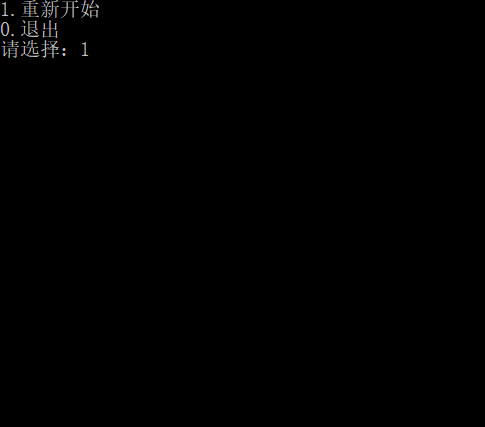在《FlappyBird》这款游戏中,玩家需要用一根手指来操控小鸟往上飞,不断的点击屏幕就会不断的往高处飞。放松手指,则会快速下降。所以玩家要控制小鸟一直向前飞行,然后注意躲避途中高低不平的管子得分。
在这里,我们主要使用C语言中的printf和scanf函数实现一个简单的FlappyBird游戏
整体思路
在开始游戏之前,我们先了解一些辅助函数
void gotoxy(int x, int y) //将光标调整到(x,y)的位置
{
HANDLE handle = GetStdHandle(STD_OUTPUT_HANDLE);
COORD pos;
pos.X = x;
pos.Y = y;
SetConsoleCursorPosition(handle, pos);
}
void HideCursor() //隐藏光标
{
CONSOLE_CURSOR_INFO cursor_info = { 1, 0 };
SetConsoleCursorInfo(GetStdHandle(STD_OUTPUT_HANDLE), &cursor_info);
}
主函数
我们使用一个简单的游戏框架,来减小游戏实现的难度
int main()
{
startup(); //初始化变量
while (1)
{
show(); //显示画面
updateWithoutInput();//与用户无关的更新
updateWithInput();//与用户输入有关的更新
}
return 0;
}
全局变量的定义
//游戏画面大小
int high; //行
int width; //列
//小鸟的坐标
int bird_x; //行
int bird_y; //列
//障碍物的相关坐标
int bar1_y; //障碍物与左边界的距离
int bar1_xTop; //上边障碍物底部与上边界的距离
int bar1_xDown; //下边障碍物顶部与上边界的距离
int score; //得分
数据的初始化
//游戏界面大小
high = 15;
width = 25;
//小鸟的初始位置
bird_x = high / 2;
bird_y = width / 4;
//障碍物的初始位置
bar1_y = width - 1;
bar1_xTop = high / 4;
bar1_xDown = high / 2;
//得分
score = 0;
显示画面
每一次循环,都需要重新输出一次画面,在这里,我们使用 @ 表示小鸟, * 表示障碍物
for (i = 0; i < high; i++) //行
{
for (j = 0; j < width; j++) //列
{
if ((i == bird_x) && (j == bird_y)) //输出小鸟
{
printf("@");
}
else if ((j == bar1_y) && ((i < bar1_xTop) || (i > bar1_xDown))) //输出障碍物
{
//只有在合适的列时才需要去判断是否需要输出*,所以需要利用&&的性质,第一个条件成立之后才去判断第二个条件
printf("*");
}
else
{
printf(" ");
}
}
printf("\n");
}
printf("得分:%d\n", score);
与用户无关的更新
实现小鸟的下落和障碍物的移动
bird_x++; //小鸟向下落
bar1_y--; //小鸟只是在上下移动,障碍物向左移动
判断游戏的得分与失败
if (bird_y == bar1_y) //障碍物与小鸟在同一列
{
if ((bird_x >= bar1_xTop) && (bird_x <= bar1_xDown)) //得分
{
score++;
}
else //不能撞墙
{
printf("游戏失败!!!");
return -1;
}
}
else
{
if (bird_x > high) //小鸟不能落到high以下
{
printf("游戏失败!!!");
return -1;
}
}
重新生成障碍物
if (bar1_y <= 0) //新生成一个障碍物
{
bar1_y = width - 1;
//随机生成障碍物与开口大小
int upside = rand() % (int)(high * 0.6) + 1; //防止上侧障碍物出现在边界
bar1_xTop = upside;
int opening = rand() % (int)(high * 0.2) + 2; //开口大小随机,且开口不能太小
while ((bar1_xDown = bar1_xTop + opening) > high - 2) //防止下侧障碍物过小
{
opening = rand() % (int)(high * 0.2) + 2;
}
}
与用户输入有关的更新
游戏在运行的过程中,用户需要输入空格来使小鸟向上跳动
if (_kbhit())
{
input = _getch();
if (input == ' ' && bird_x > 0)
{
bird_x = bird_x - 2;
}
}
关于_kbhit()和_getch()函数可以在《使用c语言实现飞机游戏》中getch函数部分查看,链接:https://blog.csdn.net/lw13572259173/article/details/81662103
完整代码
#include <stdio.h>
#include <windows.h>
#include <stdlib.h>
#include <conio.h>
#include <time.h>
//辅助函数
void gotoxy(int x, int y) //将光标调整到(x,y)的位置
{
HANDLE handle = GetStdHandle(STD_OUTPUT_HANDLE);
COORD pos;
pos.X = x;
pos.Y = y;
SetConsoleCursorPosition(handle, pos);
}
void HideCursor() //隐藏光标
{
CONSOLE_CURSOR_INFO cursor_info = { 1, 0 };
SetConsoleCursorInfo(GetStdHandle(STD_OUTPUT_HANDLE), &cursor_info);
}
//全局变量的定义
//游戏画面大小
int high;
int width;
//小鸟的坐标
int bird_x;
int bird_y;
//障碍物的相关坐标
int bar1_y;
int bar1_xTop;
int bar1_xDown;
int score;
void startup() //数据初始化
{
//游戏界面大小
high = 15;
width = 25;
//小鸟的初始位置
bird_x = high / 2;
bird_y = width / 4;
//障碍物的初始位置
bar1_y = width - 1;
bar1_xTop = high / 4;
bar1_xDown = high / 2;
//得分
score = 0;
}
void show() //显示画面
{
gotoxy(0, 0); //将光标调整到(0,0)的位置
int i, j;
for (i = 0; i < high; i++)
{
for (j = 0; j < width; j++)
{
if ((i == bird_x) && (j == bird_y)) //输出小鸟
{
printf("@");
}
else if ((j == bar1_y) && ((i < bar1_xTop) || (i > bar1_xDown))) //输出障碍物
{
printf("*");
}
else
{
printf(" ");
}
}
printf("\n");
}
printf("得分:%d\n", score);
}
int updateWithoutInput()//与用户无关的更新
{
bird_x++;
bar1_y--;
if (bird_y == bar1_y)
{
if ((bird_x >= bar1_xTop) && (bird_x <= bar1_xDown))
{
score++;
}
else
{
printf("游戏失败!!!");
return -1;
}
}
else
{
if (bird_x > high)
{
printf("游戏失败!!!");
return -1;
}
}
if (bar1_y <= 0)
{
bar1_y = width - 1;
int upside = rand() % (int)(high * 0.6) + 1;
bar1_xTop = upside;
int opening = rand() % (int)(high * 0.2) + 2;
while ((bar1_xDown = bar1_xTop + opening) > high - 2)
{
opening = rand() % (int)(high * 0.2) + 2;
}
}
Sleep(150);
return 0;
}
void updateWithInput()//与用户输入有关的更新
{
char input;
if (_kbhit())
{
input = _getch();
if (input == ' ' && bird_x > 0)
{
bird_x = bird_x - 2;
}
}
}
int main()
{
srand((unsigned)time(NULL));
HideCursor();
again:
startup(); //初始化变量
while (1)
{
show(); //显示画面
int ret = updateWithoutInput();//与用户无关的更新
if (ret == -1)
{
system("CLS");
printf("1.重新开始\n0.退出\n请选择:");
int input = 0;
scanf("%d", &input);
if (input)
{
goto again;
}
else
return 0;
}
updateWithInput();//与用户输入有关的更新
}
return 0;
}
效果演示
在这里,我们从游戏失败之后重新开始演示
总结
到这里,我们的FlappyBird游戏已经实现完了,多有不足之处,任需要继续改进。


























 1040
1040











 被折叠的 条评论
为什么被折叠?
被折叠的 条评论
为什么被折叠?








